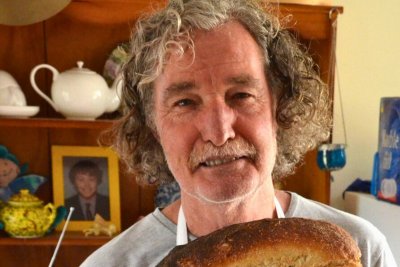Sustain / Real Bread Campaign / Articles
Sourdough Down Under
John Downes, a pioneer of the Australian sourdough revival, on the journeys that led to his new book.

My original fermentation illumination was from a muse to be sure. In the before time, I had been cheffing (well, cooking, really) in my busy, groovy, early ‘70s café in Byron Bay, New South Wales, where the freshly pressed apple juice didn’t always get drunk. It was too busy and someone had driven all the way from Sydney just to get my black bean mud crab, so how could I turn him away? The following day, during lunch service, I rediscovered that apple juice, now sporting a foaming, brownish head and sparkling with bubbles.
The muse allows no escape. There was a bag of freshly milled flour nearby, which became a leaven and then a dough, which rose quite rapidly in the warm, humid air. It was in the oven, then emerging radiant onto a cooling rack in a blur. We all stared at this glowing, russet loaf in disbelief and with a good deal of reverence. Could it really be that easy?
Light my fire
After this, I trod a path that, in 1979, led to my first decent Scotch wood-fired bread oven in the ill-fated Feedwell Foundry in Prahran, Melbourne. Then in 1984, a serendipitous find behind a wall-panel at the back of a fish shop in Carlton, Melbourne - a 100 loaf wood-fired oven that became the heart of Natural Tucker Bakery. Then there was the oven at Firebrand Sourdough Bakery in Ripponlea, also Melbourne, with its unusual V-shaped crown. After this I had the massive, 200 loaf oven rebuilt at a traditional bakery in Newrybar, near Byron Bay.
My favourite bread ovens are the easy-to-build, very traditional, round or oval brick ones, common everywhere that bread is made. What you might think of as a village or pizza oven. These bake about 10 to 30 loaves, usually allow successive loads and retain sufficient residual heat for pastries, cakes, breakfast grains and biscuits. Historically, the falling heat was also used to stew fruit in jars and even to dry feathers.
Small wood-fired ovens are ideal for bakers who sell at farmers’ markets, or even families and groups of neighbours/friends who want to enjoy great bread and other baked foods. They can be very economical, using waste in the form of log-like tight bundles of hemp stems or prunings from pollarded trees, maintaining both the tree and the baker.
Fermentation fanatic
What fascinated me as I travelled in Asia (‘the continent’ for we Strayans) was fermented food everywhere. From mellow, handcrafted miso and tempeh, to tapeh made from tapioca in Indonesia, there was always something fermented to be enjoyed. That’s not forgetting the heady, spontaneously fermented palm sap - a laugh until it kicks in and you have to be carried home.
In India it was idli that first got my attention. These are made from a batter of spontaneously fermented ground rice and urad dal, cooked en masse in a cleverly efficient stacked steamer. They are not dissimilar to the British crumpet but with a cakey texture. The idli is one of the most innovative and toothsomely delicious ferments ever, especially when accompanied by flavoursome sambar (a vegetable and lentil soup) and properly made, by which I mean fermented rather than puffed up by baking powder - believe me, some are! It is a very convenient way to make a nutritious, gluten-free sourdough bread.
The process is simple and steaming is a lot easier than baking. They also make AMAZING TOAST! Best served buttered greedily or soaked with ghee and honey, or (with culturally appropriating apologies) extra virgin olive oil or tahina.
Though both are true sourdough breads, idli is the opposite of pain au levain. An idli is soft, pale and mild throughout, while pain au levain is crusty, with deep and complex flavours. Idli are born of steam, pain au levain is born of fire. They are perfect reflections of food-for-climate and sourdough biomes.
There’s more, everywhere. I’ve done so much baking, doggedly (alright fanatically) finding old, wood-fired brick ovens or building them, because they bake the best – in myriad ways – bread. I know we can’t all do that and I’ve been lucky to pluck a life out of what has essentially been a heart-over-head adventure. So much so that one well-known culinary expert/friend once called me ‘an atavism’, though I’m not the only one it seems.
Brought to book
Why did I write The Sourdough Loaf? I’m always searching for motivations and, truthfully, the book wrote me. Cute, I know, but it became apparent that I was tapping into a wellspring. It evolved into a template for small-scale, local-market-oriented breadsmithing. My aims in writing it included exemplifying creative baking and re-creating some specialties, which now become relevant again as we wish to eat interesting, wholesome food and support local enterprise. For example, saffron buns are brilliant at your local market to replace the tired old hot cross buns.
The book is also suitable for home bakers. I made a lot of the breads in a very average home kitchen because, as many home bakers who are unable to get their own oven know, necessity leaves us reliant on whatever oven is there. Such are the small-bake perils.
I hope my experiences with near-forgotten (or simply ignored) aspects of the traditional baker’s craft finds some relevance among Real Bread fanatics who, like me, draw greedily from the wellspring of healthy, delicious baking and eating.
Originally published in True Loaf magazine issue 58, April 2024.
Published Tuesday 10 September 2024
Real Bread Campaign: The Real Bread Campaign finds and shares ways to make bread better for us, better for our communities and better for the planet. Whether your interest is local food, community-focussed small enterprises, honest labelling, therapeutic baking, or simply tasty toast, everyone is invited to become a Campaign supporter.

